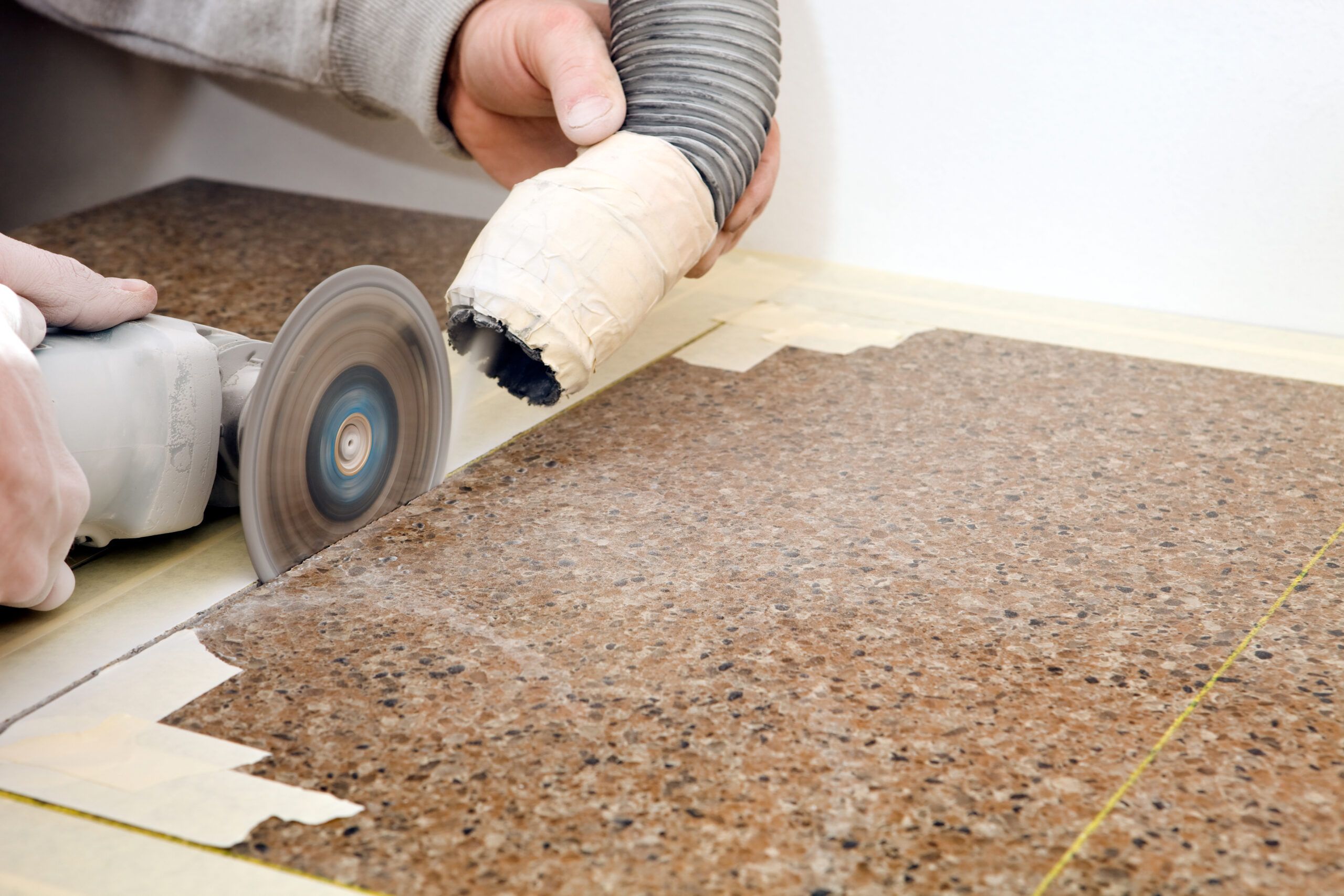To cut slate by hand, use a slate cutter or a hammer and chisel to score and snap the material. Ensure personal safety by wearing goggles and gloves during the process.
Slate, a natural stone with a layered construction, finds its place in a variety of applications ranging from roofing to flooring, and even crafting. Cutting slate manually might seem daunting, but with the right tools and a steady hand, it’s a task that many DIY enthusiasts can undertake successfully.
Ensuring the integrity of the slate’s finish and preventing unwanted breakage requires a methodical approach. Beginners and seasoned pros alike often prefer the hand-cutting technique for its precision and the control it offers. When preparing to size your slate for that perfect fit, understanding the correct hand-cutting process will both improve the quality of your work and extend the life of your materials.
Introduction To Slate Cutting
Slate cutting by hand is an age-old art form. It transforms natural slate into beautiful, functional pieces. Whether for home improvements, art, or construction, cutting slate manually is a skill worth learning. With the right tools and techniques, anyone can craft intricate designs and precise shapes from raw slate. Let’s dive into the allure of slate in craftsmanship and the essential tools needed for this hands-on process.
The Appeal Of Slate In Craftsmanship
Slate’s unique texture and durability make it a favorite among craftsmen. It has a timeless elegance that stands out in roofing, flooring, and artistic endeavors. The natural variations in color and pattern ensure that each slate piece is one-of-a-kind. By cutting slate by hand, artisans can control the shape and finish, lending a personal touch to every project.
Key Tools For Manual Slate Cutting
Successful slate cutting requires specific tools. First, a slate cutter, which looks like oversized scissors, is used for making straight cuts. For more precision, a slate ripper helps remove unwanted slate pieces. Finally, a hammer and chisel are essential for detailed shaping. With these tools, hand-cutting slate becomes a precise and rewarding craft.
- Slate Cutter: Creates straight, clean cuts.
- Slate Ripper: Removes unwanted slate with ease.
- Hammer and Chisel: Ideal for detailed shaping and trimming.
Safety First: Preparing To Cut Slate
Before you dive into your slate project, it’s crucial to prioritize safety. Cutting slate by hand requires careful preparation to avoid accidents. We’ll guide you through the essentials of gearing up and setting the right environment for your task.
Selecting The Right Protective Gear
Proper protective equipment is vital when handling slate. Slate shards can be sharp and dangerous. Here’s what you need:
- Safety Glasses: Protect your eyes from dust and shards.
- Gloves: Choose sturdy gloves to shield your hands.
- Respirator Mask: Prevent inhalation of slate dust.
- Ear Protection: Use earplugs or earmuffs against noise.
- Long-sleeved Clothing: Cover skin to prevent cuts.
Once you have these items, you’re set to cut slate safely.
Setting Up A Safe Work Environment
A well-prepared workspace is key to safety. Here’s how to set up:
| Step | Action | Reason |
|---|---|---|
| 1 | Clear the Area | Prevents tripping over tools or materials. |
| 2 | Stable Work Surface | Keeps the slate secure while cutting. |
| 3 | Good Lighting | Ensures you can see what you’re doing. |
| 4 | Keep Water Nearby | Dust suppression and quick cleanup. |
| 5 | No Distractions | Focus is essential for safe handling. |
With your gear on and workspace ready, you’re all set to cut slate effectively and securely.
Understanding Slate
Slate is a natural stone that craftsmen have treasured for centuries. Its durability and timeless beauty make it a preferred choice for roofing, flooring, and even artistic sculptures. However, working with slate requires a specific set of skills and knowledge, especially when it comes to cutting it by hand. Before attempting to cut slate, it’s important to understand its unique characteristics and how to identify its grain.
Characteristics Of Slate
Slate is a metamorphic rock, which means it formed under heat and pressure from other types of rock. This process gives slate several defining characteristics:
- Fine-grained texture: It feels smooth to the touch.
- Cleavage planes: It splits easily along flat, parallel layers.
- Toughness: While tough, it can be brittle and may chip.
- Color variety: Slate comes in shades of gray, blue, green, red, and brown.
Identifying The Grain Of The Slate
Like wood, slate has a grain, which is integral for cutting it properly. The grain refers to the direction of the slate’s natural layers. To identify the grain, observe the slate’s surface and look for a series of lines or ripples. These indicate the layers and the direction they run. Here’s a step-by-step guide:
- Examine the edge of the slate to see the layering.
- Look for a ripple effect on the surface.
- Feel the surface: The smoother side typically has the grain running along its length.
Cutting parallel to the grain will result in a smoother, more controlled split, while cutting against it might cause unwanted breaks or chips. Always prioritize following the natural grain of the slate for the best results.
Marking And Measuring
Getting that perfect slate cut starts with two important steps: Marking and Measuring. Whether creating a piece for your home or working on a professional project, precision in these preliminary stages sets the tone for your entire undertaking.
Tools For Accurate Marking
Marking your slate accurately is crucial to ensure you get the intended size and shape. Here are the key tools you will need:
- Carbide-tipped scribe – Leaves a sharp, clear line to follow when cutting.
- Chalk line – Ideal for snapping long, straight, consistent guide lines.
- Ruler or straight edge – Ensures straight lines over short distances.
- Measuring tape – For getting exact dimensions of the slate piece.
- Combination square – Helps in achieving perfect right angles.
Tips For Precise Measurements
With the right marking tools, you’re set to measure with precision. Here are some tips to help you keep measurements spot on:
- Double-check numbers – Always measure twice before marking to avoid mistakes.
- Keep the tape straight – Ensuring your measuring tape is straight will prevent inaccuracies.
- Use a firm hold – Secure the slate so it does not move while marking.
- Mark lightly but visibly – Ensure the mark is visible but not too deep to damage the slate’s surface.
- Use the right mark for your tool – A scribe might require a different mark type than chalk.
The Cutting Process
Mastering the cutting process of slate by hand combines ancient skill with intention. Whether you’re crafting a unique pathway, roofing your dollhouse, or personalizing a coaster, follow these time-tested techniques to split slate cleanly and effectively.
Scoring The Slate
The first crucial step is scoring. This term means creating a shallow cut on the slate which acts as a guide for the break. Use these steps:
- Place the slate on a stable, flat surface.
- Mark your cut line with chalk for visibility.
- Align a straight edge along the line for precision.
- Hold a scoring tool firmly and drag it along the straight edge.
- Repeat the scoring until you have a clear indentation.
Applying Pressure For The Break
Breaking the slate requires steady pressure. Follow these steps for a clean break:
- Position the scored line just beyond the edge of the work surface.
- Place a hand on either side of the score, wearing safety gloves.
- Press down swiftly and firmly on the section of slate that is overhanging.
- The slate should snap cleanly along the scored line.
Always wear safety goggles to protect your eyes from shards during the break.

Credit: www.crafterscompanion.com
Refining And Smoothing Edges
Once you’ve successfully split your piece of slate, refining and smoothing its edges is the next critical step. This process will give your slate a professional and polished look, essential for a range of projects, from roofing to decorative pathways.
Using A Slate Trimmer
Smooth edges on slate can make the difference between a DIY project and a professional finish. A slate trimmer is a go-to tool for this task. Here’s how to use it:
- Place the slate into the trimmer.
- Align the edge you want to trim with the blade.
- Apply steady pressure to snap off the excess.
The trimmer allows you to take off larger, rough edges quickly and efficiently.
Sanding For A Finished Look
For that extra smooth finish, sanding is essential. Follow these simple steps:
- Start with a rough grit sandpaper.
- Sand the edge in a circular motion.
- Progress to finer grit sandpaper for a smooth finish.
Sanding not only refines the slate’s edge but also prepares it for sealants or treatments.
Finishing Touches
After carefully cutting the slate by hand, the final steps ensure its beauty and durability. Sealing and maintenance play key roles in protecting your handiwork. Through these finishing touches, your slate will stand the test of time and weather.
Sealing The Slate
Sealing is essential to safeguard the slate’s natural elegance. It prevents water absorption and stains, keeping the slate’s appearance pristine. Follow these simple steps:
- Clean the slate thoroughly. Ensure it’s dry.
- Choose the right sealant. Look for one suitable for slate.
- Apply the sealant evenly. Use a brush or roller.
- Allow it to dry completely.
Check the sealant’s instructions for the drying time. Apply additional coats if necessary.
Maintenance Tips For Longevity
Regular maintenance keeps your slate in top condition. Here’s how:
- Wipe spills immediately to prevent marks.
- Conduct a routine cleaning with mild detergent and water.
- Avoid acidic cleaners. They can damage the slate.
- Inspect the slate for cracks or chips. Repair promptly.
- Reapply sealant every few years. Consult the sealant’s guide for frequency.
Maintaining your slate is simple. It preserves its beauty and extends its lifespan significantly.
Troubleshooting Common Issues
Tackling the challenges of hand-cutting slate requires patience and skill. Occasionally, the slate may not break cleanly or cutting can prove difficult. This section provides practical solutions for common issues encountered during the cutting process.
Dealing With Irregular Breaks
Irregular breaks in slate can be frustrating. They often result from improper scoring or inadequate support. To address this:
- Score the slate deeply and evenly.
- Ensure the support is stable and flat.
- Apply even pressure when snapping the slate.
Using a sharpening stone can smooth out rough edges. For complex shapes, consider making multiple smaller cuts to control the break.
Overcoming Cutting Difficulties
Several factors contribute to cutting difficulties. The thickness of the slate or a dull tool could be the culprit. To overcome this:
| Problem | Solution |
|---|---|
| Thick Slate | Increase score depth; snap slowly. |
| Dull Tool | Sharpen or replace the cutting tool. |
| Uneven Surface | Work on a flat, stable surface. |
For thicker slabs, using a sledgehammer and chisel may be necessary. Remember to wear safety goggles and gloves to protect against sharp fragments.
Creative Uses For Hand-cut Slate
The versatility of slate makes it perfect for creative projects. Whether in your home or garden, the natural beauty of hand-cut slate shines through. It is sturdy and weather-resistant. Once you learn how to cut slate by hand, endless possibilities for DIY projects await.
Home Decor Projects
Bold textures and colors come alive in home decor projects using slate. These are some ideas:
- Coasters: Protect tables with unique slate coasters.
- Wall art: Create a statement piece for your living room.
- Serving trays: Impress guests with rustic elegance.
- House numbers: Display your address with classic style.
Slate’s natural durability makes these projects long-lasting decorations for any home.
Garden Landscaping Elements
Give your garden a polished look with hand-cut slate. Use these tips:
- Pathway stones: Guide guests with charming footpaths.
- Plant labels: Mark herbs and vegetables neatly.
- Water features: Enhance tranquility with slate designs.
- Border edging: Define flower beds sharply.
Slate blends seamlessly with outdoor settings, adding texture and depth to any garden.

Credit: www.thisoldhouse.com
Frequently Asked Questions Of How To Cut Slate By Hand
What Is The Best Thing To Cut Slate With?
The best tool to cut slate is a diamond-tipped wet saw. This device ensures precise cuts and reduces slate breakage during the cutting process.
How Do You Cut Slate Without A Saw?
To cut slate without a saw, use a slate cutter or a utility knife to score a line, then snap the slate along the scored line. You can also use a hammer and chisel to carefully break the slate. Ensure personal safety by wearing protective gear.
What Is The Best Tool To Cut Slate Slabs?
The best tool to cut slate slabs is a diamond blade wet saw, ensuring precision and smooth cuts.
Can You Cut Slate With A Chisel?
Yes, you can cut slate with a chisel by scoring and then gently breaking it along the scored line. Use protective gear to ensure safety.
Conclusion
Mastering the technique of hand-cutting slate is an empowering skill for any DIY enthusiast. With the right tools, patience, and precision, you’ll find that creating custom shapes and sizes can be both fulfilling and cost-effective. Embrace the challenge and enjoy the satisfaction of your handcrafted slate projects.










Leave a Reply